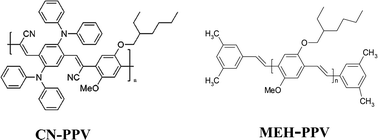Pdots, a new type of nanoparticle, bind to mTHPC via their lipid modified surface and exhibit very high FRET efficiency between the core and the sensitizer
Abstract
Pdots are a new type of nanoparticle which exhibit strong potential for future applications in biophysics and cell biology. They are composed of organic chromophoric polymers, whose surfaces can be modified with different amphiphilic polymers, such as PEGylated lipids to make them very stable as colloids in water. We demonstrate in this manuscript that the lipid nano-coating around the Pdot can bind very efficiently to amphiphilic molecules, such as photosensitizers e.g. meso-tetrahydroxyphenylchlorin (mTHPC). As a result the sensitizer is brought into very close contact with the cores of the Pdots, and resonance energy transfer from the core to the sensitizer is very efficient; in some cases it is close to 1. We show the spectroscopic properties of two types of Pdots; their sizes, which are in the 13–47 nm range, depend on the kind of polymer and the length of the PEGylated lipid chains that wrap it. We measured the efficiency of FRET by investigating the decrease in donor intensity or its lifetime upon binding with mTHPC. We also show the relative yields of singlet oxygen that are obtained via two pathways: by exciting the Pdots which transfer the energy to the attached sensitizer, or by exciting the sensitizer directly. This methodology could be used to enhance the use of a photosensitizer by employing both pathways in parallel.


 Please wait while we load your content...
Please wait while we load your content...